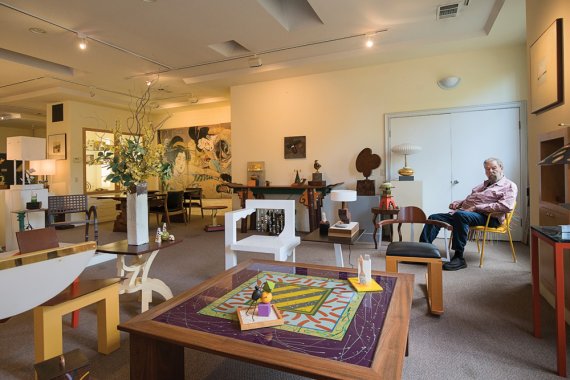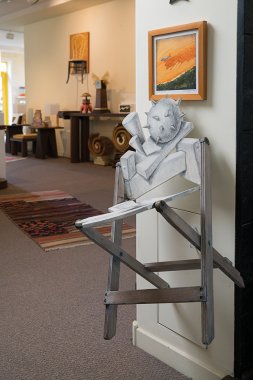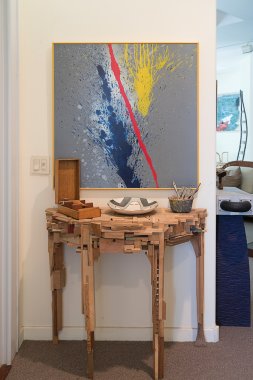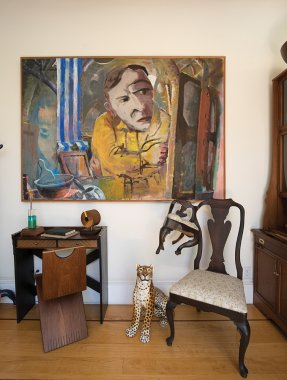Relationship Goals
Relationship Goals
Furniture maker Garry Knox Bennett and his wife, Sylvia, are partners in love, life, and business. The duo first met in high school in the Bay Area when Garry was a senior and Sylvia a freshman; it was the start of a relationship that has spanned more than six decades.
Both are self-starters (Garry, 83, taught himself to make the exuberant furniture he’s known for; Sylvia, 81, taught herself business skills) who depend on each other to make a living: While Garry works in the studio, Sylvia manages the administrative side. It’s a partnership that’s helped them thrive in the arts.
These days, like most longtime couples, they’re in the habit of finishing each other’s sentences. They live in Oakland, in a converted brick warehouse: the first floor is Garry’s studio, the second floor is a gallery/showroom of his work, and the third floor is their home, spilling over with eclectic artwork from friends and flea markets.
When did each of you become interested in art and collecting?
Garry Knox Bennett: I had a substitute teacher when I was in about seventh grade, and she said, “Garry, your penmanship is so good. You’re going to be an artist.” That stuck with me.
Sylvia Bennett: Art was always a part of my life. My father was a fan of classic literature, and I was reading a lot of Shakespeare as a kid. I even got a dressing-down from the nuns at the Catholic school I went to for reading what they deemed inappropriate stuff for my age. [Laughs.] When I met Garry in high school, he was part of a group of people I hung out with. I knew he was involved with the arts in some way, but I didn’t know he painted, and I didn’t know he wrote poetry. He went to the California College of the Arts when he was 24 years old, so all our friends at the time were artists, too. And that’s when we started to really appreciate artwork and began acquiring it. We were living on $50 a month with two kids back then, starving artists in a rural community. But art was sort of our savior; it saved us on many levels.
How did you begin collecting without money?
SB: We bought work from our friends.
GKB: We were very fortunate that I had a good show at some point early on in my career. Through the show I met a guy named Mike Singer, an architect. We became friends, and then through Mike we met a bunch of other artists and started trading work with them.
SB: We furnished, literally, from the flea market and what we could scrounge together. We both had a trained eye, if you could call it that. I mean, we just knew what looked like good pieces of work. The first things we bought were furnishings.
GKB: I still remember we went to an auction and spent $2 on something we still have.
Do you ever collect artwork as an investment?
GKB: We don’t collect. We acquire.
SB: We don’t walk out the door looking for work to buy. It’s something that we just encounter, and it’s like, “Oh, that would be fun to live with.”
How do you agree on what to purchase?
SB: Usually, we would get things from people we knew and liked. It’s a very personal collection, and it has nothing to do with anything.
GKB: Whenever I had a good show, we would take a portion of the money we made and then buy something with it.
Do you ever disagree?
SB: There have been a few things I’ve gotten and then they disappeared, because I can tell it’s not his favorite thing in the world. But nothing major. Usually, Garry will say, “Go look at that, and tell me what you think.”
What are some of your favorite pieces?
GKB: Right in this room, if I had to sell stuff, the two last things I would sell are the Judy McKie table and this Howard Hack painting. They give me joy.
SB: I’d pick those two as well. There once was a Howard Hack painting we both loved. We almost didn’t purchase our house and instead got that painting. We had a very serious conversation: “Can we afford the house, or we can afford Howard’s painting? Which is it going to be?” That painting is now in a museum, but we got another one from his orchid series instead.
GKB: Howard gave it to us.
SB: Yes, this was a gift. We could never afford his work.
How would you describe your work relationship? Somehow this artist life also has to run like a business, right?
GKB: Sylvia gets all the credit for that. I can’t let anything happen to her because I don’t know anything about checkbooks, computers, or anything. Sylvia runs the business and writes the letters.
SB: Someone said to me one time, “Every artist needs a wife, male or female. Someone who can walk behind them and pick up all the slack and sort it out. Because otherwise, things just won’t work.” I always felt that curiosity was my passion; I don’t have that intense need to create that Garry has. I probably could have done my own thing artwise, which crossed my mind a few times, but I just wasn’t driven like that. When we started out, in the ’60s, we were told that what we did was impossible to do. We started our company with nothing. We didn’t have a credit card because we couldn’t get one. We started from zip and just held on to our money, one step at a time. We were very lucky. You need both dedication and luck.
And health insurance.
SB: And health insurance. It’s a no-brainer.
What advice would you give a young artist couple today?
GKB: No arguing.
SB: Oh, never. There has to be a give-and-get, and you have to work together. It has to be a shared experience. Finding that balance is key. It’s best if both people aren’t ego-driven. You need someone with a steady income and some sort of retirement.
Sylvia, what’s been gratifying about your role in this partnership, and what’s been difficult?
SB: Difficult for me was getting past the things that I hate to do, which is math and English. But once I realized that it was either me doing this or nobody, I just bit the bullet and did it. Particularly gratifying are the people you meet and are in contact with. You couldn’t find a better group than artists.
GKB: There’s nothing more boring than going to a party with doctors and lawyers and bankers.
How has Sylvia helped contribute to your success as a maker, Garry?
GKB: She’s been everything. She’s been willing to do stuff that I won’t do. And I hope I’ve done some stuff that she can’t do. It’s just been a really good marriage.
It’s been 58 years, right?
SB: July 1st, 2018.
GKB: July 1st. Yeah, that’s right. Oh, boy.








